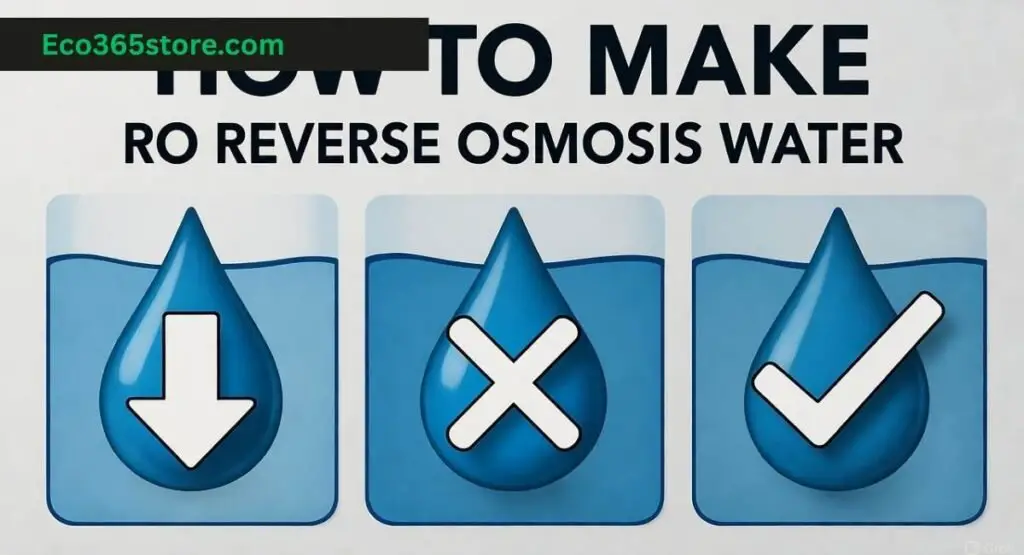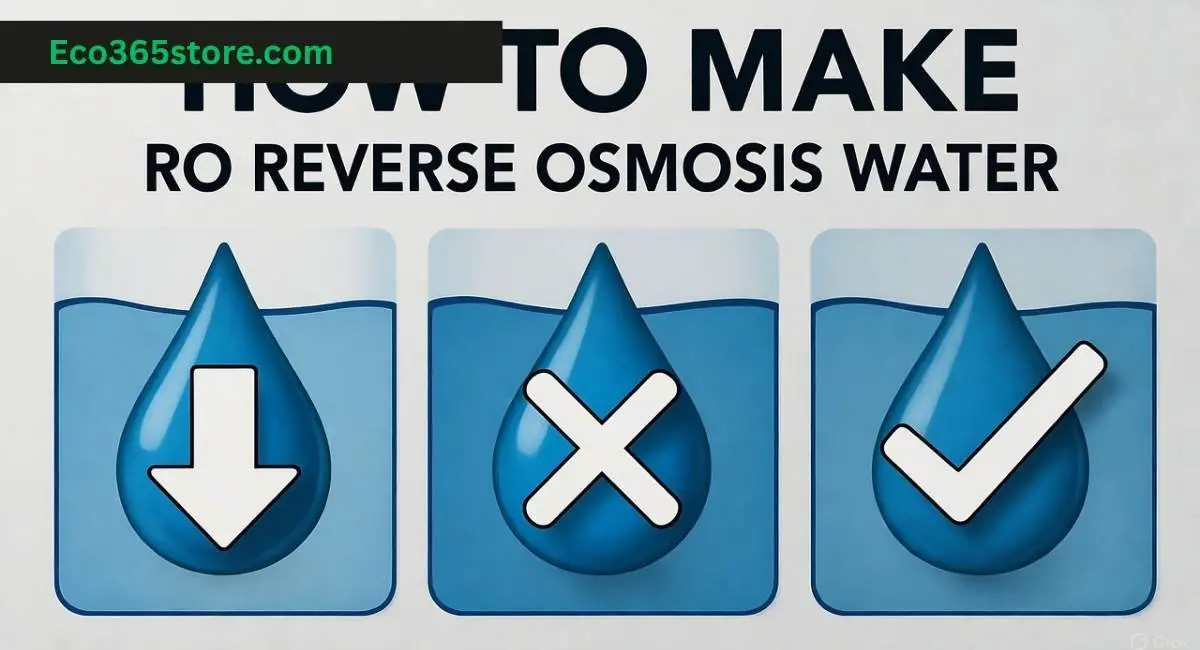In a world where water quality is increasingly uncertain, taking control of what you drink and use is more important than ever. Reverse osmosis (RO) water is renowned for its exceptional purity, removing up to 99% of contaminants like lead, chlorine, fluoride, and dissolved salts. But did you know you can produce this crystal-clean water right in your own home?
Learning how to make RO reverse osmosis water at home is a cost-effective and rewarding project. Whether for healthier drinking water, thriving plants, or a pristine aquarium, a DIY RO water purifier kit empowers you to ensure the quality of your water. This comprehensive guide will walk you through everything you need to know.
What is Reverse Osmosis Water?
Reverse osmosis is a sophisticated water purification process that forces water through a semi-permeable membrane with pores about 0.0001 microns in size. Imagine an ultra-fine sieve that only allows water molecules to pass through, while blocking contaminants such as:
- Dissolved salts and minerals (e.g., sodium, calcium, magnesium)
- Heavy metals (e.g., lead, arsenic, mercury)
- Chemical impurities (e.g., chlorine, pesticides, pharmaceuticals)
- Microbiological threats (e.g., bacteria, viruses)
The RO filtration process results in water that is not only safer but also tastes better, as it removes the elements that cause odd odors and flavors. The key RO water benefits are its unparalleled purity and consistency.

Materials and Tools Needed for Making RO Water at Home
A standard home RO system is composed of several key components that work in stages. Here’s what you’ll typically find in a DIY reverse osmosis water purifier kit:
Essential RO System Components:
- Prefilters: A sediment filter (to remove dirt and rust) and an activated carbon filter (to remove chlorine and organic compounds that can damage the RO membrane).
- RO Membrane: The heart of the system, which performs the reverse osmosis process.
- Storage Tank: Holds the purified water for on-demand use.
- RO Faucet: A dedicated faucet installed on your sink for dispensing pure water.
- Automatic Shut-Off Valve: Preserves membrane life by stopping the process when the tank is full.
- Check Valve: Prevents backflow from the tank.
- Flow Restrictor: Regulates water flow to optimize membrane performance.
- Tubing and Fittings: To connect all the components.
Optional Components:
- Post-Carbon Filter: A final “polishing” filter to improve taste after the tank.
- Remineralization Filter: Adds back beneficial minerals like calcium and magnesium for improved taste and health.
- UV Sterilizer: Provides a final safeguard against bacteria.
Step-by-Step Guide: How to Make RO Reverse Osmosis Water at Home
Installing an under-sink RO system is a manageable DIY project. Here’s a general step-by-step RO installation guide.
Phase 1: Preparation
- Choose Location: Select a spot under your kitchen sink with enough space for the unit and the storage tank.
- Shut Off Water & Power: Turn off the cold water supply under the sink. Turn off the power to the garbage disposal if you have one.
- Prepare Drain Line: Drill a 1/4″ or 3/8″ hole in the sink drain pipe for the drain line saddle clamp.
Phase 2: Install the Faucet
- Drill a hole in your sink countertop (or use an existing sprayer hole).
- Mount the RO faucet, securing it from below with the provided nut.
Phase 3: Install the RO Unit
- Mount the System: Secure the RO filter housing unit to the wall inside the cabinet.
- Connect Feed Water: Install the saddle valve onto the cold water supply line. Connect the tubing from this valve to the “IN” port of the RO system.
- Connect Drain Line: Attach one end of the drain line tubing to the “Drain” port of the RO system and the other end to the saddle clamp on your sink drain pipe.
- Connect Faucet Line: Run tubing from the “Out” port on the RO system (or post-filter) to the base of the RO faucet.
Phase 4: Install the Storage Tank
- Connect the tank to the “Tank” port on the RO system using the provided tubing.
- Open the tank valve.
Phase 5: Start the System
- Slowly open the feed water valve to supply water to the system.
- Turn on the RO faucet and let the system run for at least 30 minutes to flush the filters and membrane. Expect some initial sputtering and carbon bits—this is normal.
- Check all connections for leaks.
Making RO Water for Plants
How to make RO reverse osmosis water for plants is a common question among serious gardeners. Tap water often contains chlorine, fluoride, and dissolved salts that can accumulate in soil, harming sensitive plants like orchids, carnivorous plants, and certain succulents.
Why RO Water is Great for Plants:
- It provides a “blank slate,” free of chemicals that can cause leaf tip burn or root damage.
- It allows you to have complete control over the nutrients you add.
Important Consideration:
RO water lacks minerals. When using RO water for gardening, you must use a balanced fertilizer to provide all the essential nutrients your plants need, as you are no longer relying on tap water to supply trace minerals.
How to Make RO Reverse Osmosis Water for Aquariums
For aquarium enthusiasts, how to make RO reverse osmosis water for an aquarium is a critical skill. Tap water parameters are inconsistent and often contain phosphates, nitrates, and silicates that promote algae growth and harm sensitive fish.
Why Use RO Water in Aquariums?
- Prevents unwanted algae blooms.
- Safely accommodates delicate species like Discus or Crystal Shrimp.
- Allows you to precisely mix water to replicate specific natural habitats (e.g., soft water for Amazonian biotopes).
How to Use RO Water for Your Aquarium:
- Collect the Water: Fill a clean container with freshly made RO water.
- Re-mineralize: Use a commercial product like Seachem Replenish or Salty Shrimp GH+ to restore the necessary General Hardness (GH) and Carbonate Hardness (KH). This is non-negotiable for fish health.
- Adjust Temperature: Heat the water to match your aquarium’s temperature.
- Add a Water Conditioner: Even though RO water lacks chlorine, a conditioner that neutralizes heavy metals is a good safety practice during remineralization.
This aquarium water purification process ensures a stable, healthy environment for your aquatic life.
Best DIY Reverse Osmosis Systems and Kits
When choosing the best DIY reverse osmosis system, consider your budget, space, and water needs.
- Standard Under-Sink Systems: These are the most popular and cost-effective. Kits from brands like APEC Water, iSpring, and Home Master offer great value and are designed for easy DIY RO water purifier kit installation.
- Countertop RO Systems: These require no permanent installation and are perfect for renters. They are connected directly to the faucet but may have a slower output.
- Tankless/Compact RO Systems: These save space under the sink but can be more expensive.
Maintenance Tip: Regardless of the kit you choose, adhere to a strict filter replacement schedule (typically every 6-12 months for prefilters and 2-3 years for the membrane) to ensure consistent water quality.
Testing and Maintaining Your RO System
Proper RO system maintenance is simple but crucial.
- Test Your Water: Use a TDS meter to measure Total Dissolved Solids. A reading of < 50 ppm indicates your system is working well. A high or rising TDS reading is a clear sign your membrane or filters need replacement.
- Change Filters Regularly: Follow the manufacturer’s schedule. Clogged filters reduce water pressure and strain the membrane.
- Sanitize Periodically: It’s good practice to sanitize the entire system, including the tank, when replacing the membrane to control any bacterial growth.
Safety and Health Considerations
The primary concern with RO water is its lack of minerals. While it is perfectly safe RO water, some studies suggest that long-term consumption of completely demineralized water might not be ideal.
The Solution: Remineralization.
For drinking and cooking, the best practice is to use a remineralized RO water filter. This is an added stage that infuses water with a balanced blend of calcium and magnesium, dramatically improving the taste and adding back beneficial electrolytes. This makes the water both pure and healthy for daily consumption.
Conclusion
Learning how to make RO reverse osmosis water is a powerful step toward self-sufficiency and health. With a DIY RO water purifier kit, you can reliably produce some of the purest water available for drinking, gardening, and aquariums. The installation process is a manageable weekend project that pays for itself in peace of mind and reduced plastic bottle waste.
Take the plunge into making reverse osmosis water at home. Your taste buds, your plants, and your fish will thank you.
Have you installed a DIY RO system? Share your experiences and questions in the comments below!
Can you make reverse osmosis water without a full system?
Not practically. The RO process requires high water pressure achieved only by a dedicated system with a membrane and filters.
How long does it take to make RO water?
It’s a slow process. A standard system may take 2-4 hours to fill a 3-gallon tank. This is why a storage tank is essential for on-demand use.
Is RO water better than distilled water for plants or aquariums?
For these uses, they are functionally identical—both are pure, mineral-free water. The choice comes down to cost and convenience, with RO typically being cheaper to produce at home.
What’s the cost of setting up a home RO water system?
A quality DIY RO water purifier kit typically costs between $150 and $500. While the initial investment is higher than a pitcher filter, the cost per gallon is significantly lower over time.

Anamika is a passionate writer for Eco365Store.com, specializing in topics that inspire a cleaner, greener world. With expertise in home cleaning, recycling, and eco-friendly solutions, she crafts engaging and informative articles that help readers adopt sustainable practices in their daily lives.

